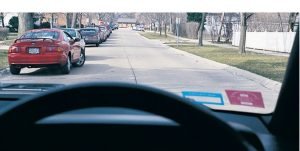Safe driving depends on your ability to notice many things at once. Our eyes provide two types of visions: central vision and peripheral or side vision. Central vision allows us to make very important judgments like estimating distance and understanding details in the path ahead, whereas peripheral vision helps us detect events to the side that are important to us, even when we’re not looking directly at them. Most driving mistakes are caused by bad habits in the way drivers use their eyes.
IPDE (Identify, Predict, Decide, and Execute) is an important concept in defensive driving. To know more about its principles, read carefully the following section.
In order to avoid last-minute moves and spot possible traffic hazards, you should always look down the road ahead of your vehicle. Start braking early if you see any hazards or traffic ahead of you slowing down. Also, check the space between your car and any vehicles in the lane next to you. It is very important to check behind you before you change lanes, slow down quickly, back up, or drive down a long or steep hill. You should also glance at your instrument panel often to ensure there are no problems with the vehicle and to verify your speed.


